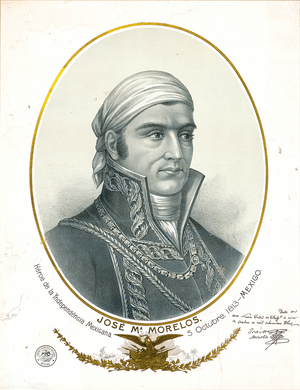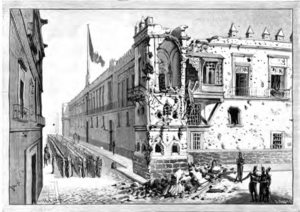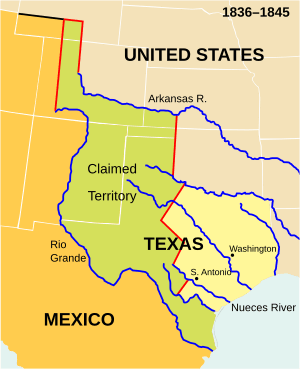Juan Almonte facts for kids
Quick facts for kids
Juan Nepomuceno Almonte
|
|
|---|---|
| President of the Regency of Mexico | |
| In office 11 July 1863 – 10 April 1864 |
|
| Preceded by | Agustín de Iturbide |
| Succeeded by | Monarchy abolished |
| Regent of the Mexican Empire with José Salas and Antonio de Labastida |
|
| In office 11 July 1863 – 10 April 1864 |
|
| Monarch | Maximilian I of Mexico |
| Succeeded by | Maximilian I of Mexico |
| Personal details | |
| Born | May 13, 1803 Nocupétaro, New Spain (now Michoacán, Mexico) |
| Died | March 21, 1869 (aged 65) Paris, France |
| Political party | Conservative |
| Spouse | María Dolores Quesada |
| Children | María de Guadalupe Almonte |
| Occupation | Military officer, diplomat |
| Awards | |
| Signature | |
| Military service | |
| Allegiance | Second Mexican Empire |
| Rank | General |
| Battles/wars | Texas Revolution • Battle of the Alamo • Battle of San Jacinto Mexican–American War War of Reform Second French intervention in Mexico |
Juan Nepomuceno Almonte Ramírez (born May 15, 1803 – died March 21, 1869) was an important Mexican figure. He was a soldier, a military leader, a government minister, a diplomat, and even a regent.
Juan Almonte was the son of José María Morelos, a famous leader in Mexico's fight for independence. Almonte played a big part in Mexican politics as a conservative. He served as the Minister of War many times and worked as a diplomat in the United States and Europe. He also helped bring back a monarchy (a government led by a king or emperor) to Mexico. He supported the French forces during their intervention in Mexico and the creation of the Second Mexican Empire under Maximilian I of Mexico. Almonte was working as a diplomat in France when the French army left Mexico. He passed away in 1869.
Contents
Early Life and Education

Juan Almonte was born in Nocupétaro, a town in Michoacán, Mexico. His father was José María Morelos, a Catholic priest who led the Mexican War of Independence from 1811 to 1815. His mother was Brígida Almonte.
In 1815, Morelos sent Juan to New Orleans, Louisiana, in the United States. There, Juan received an education and learned to speak English very well. His father sent him away for his safety. While in New Orleans, Juan worked as a clerk. His time there ended when his father was executed in December 1815.
Between 1822 and 1824, Almonte worked for a rebel leader named José Félix Trespalacios in Texas. Later, he joined the Mexican delegation sent to London. He helped Ambassador José Mariano Michelena create Mexico's first treaty with England. This treaty was about trade and friendship for the new nation.
Almonte was a supporter of Vicente Guerrero, a liberal leader who became president in 1828. When Guerrero was overthrown, Almonte had to hide. He also worked as an editor for a newspaper called Atleta (The Athlete), which was later shut down.
On March 1, 1840, Almonte married María Dolores Quesada in Mexico City. They had a daughter named María de Guadalupe.
Texas Revolution
In 1834, Vice President Valentín Gómez Farías asked Almonte to inspect Texas and write a report. In early 1836, Almonte became an assistant to General Antonio López de Santa Anna. He went with Santa Anna to Texas to stop the rebellion there.
Santa Anna's army went to San Antonio de Bexar, where a small group of Texian rebels were at the Alamo. Almonte met with a Texian messenger and told him that any surrender must be unconditional. After the battle, Almonte wrote in his journal that 250 Texians died. He also noted that five women, one Mexican soldier, and one enslaved person survived.
Almonte is believed to have helped save Susannah Dickinson, one of the survivors. She later said a Mexican officer helped save her and her daughter's lives. This officer was likely Almonte.
On April 21, 1836, Almonte surrendered to Texian General Thomas J. Rusk at the Battle of San Jacinto. Almonte led the last organized group of Mexican soldiers. The next day, Santa Anna was also captured. Almonte stayed with Santa Anna during his imprisonment, acting as an interpreter and helping with negotiations.
They were held for several months. Later, Almonte and Santa Anna were sent to Washington, D.C., to meet with U.S. President Andrew Jackson. They returned to Mexico in February 1837. Santa Anna was no longer president, but Almonte continued his military and diplomatic career. He became a major general and published a book on geography in 1837.
Minister of War

By 1839, Almonte was serving as the Minister of War under a conservative government. He strongly believed in Mexico's right to govern itself. He proposed a law to Congress that would declare Mexicans who sought foreign help as traitors. This law was passed.
During the Federalist Revolt of 1840, President Anastasio Bustamante was taken hostage by rebels in the National Palace. Fighting lasted for a week in Mexico City. Almonte led the loyal government troops to rescue the president. His efforts were successful, and the National Palace was taken back.
After this fighting, a writer named Jose Maria Gutierrez Estrada suggested that Mexico should invite a European prince to become emperor. He believed this would bring stability after years of civil war. Almonte, surprisingly, strongly disagreed. He called the idea scandalous and against the Mexican constitution. As Minister of War, he ordered copies of the essay to be taken away. He also told the military that Estrada's ideas were "treason."
President Bustamante was overthrown in 1841. The finance minister became interim president but went into hiding. Almonte, as Minister of War, became the acting head of the government in Mexico City. He supported bringing back a federal system of government. However, rebels took control, and a conservative, centralist government was established.
Mexican-American War
Almonte continued to serve in the government. In 1841, he became Mexico's minister to the United States. He worked to prevent the U.S. from interfering in Texas and tried to keep good relations between the two countries.
When the U.S. Senate voted to make Texas part of the United States, Almonte resigned his diplomatic post. This event convinced Almonte that Mexico needed to oppose U.S. expansion, even if it meant seeking help from European countries.
Almonte ran for president in 1845 but lost. The new president tried to keep Texas as a separate buffer state, but he was overthrown. The American invasion of Mexico began in April 1846. Almonte was again made Minister of War. He advised President Paredes to find foreign allies to help Mexico fight the United States.
Almonte was on his way to France as a minister when he met Santa Anna in Cuba. Santa Anna was planning to return to Mexico during a time of military failures and a coup against the current president.
Paredes was overthrown, and Almonte became Minister of War in the new government. He organized the national guard, bought weapons, and planned military actions. He also argued that Mexico should ignore American demands.
The Reform War and French Intervention
After the Mexican-American War, Almonte ran for president in 1848 and 1852. He was also elected to Congress in 1849. He was a strong opponent of the presidents Jose Joaquin Herrera and Mariano Arista.
Almonte did not have a government role during Santa Anna's last time as dictator (1852–1853). But after Santa Anna was overthrown, Almonte became Minister to Great Britain in 1853. During this time, he began to seek foreign help for Mexico, something he now believed was necessary.
In 1858, a conservative group overthrew the government, starting the Reform War. Almonte stayed with the new government and was sent to Paris as Minister to France. In 1859, he signed the Mon-Almonte Treaty with Spain. This treaty arranged for Mexico to pay Spain for damages to its citizens. The Reform War ended in 1860 with a victory for the liberals.
The French intervention in Mexico began because Mexican President Benito Juarez stopped paying interest on loans to French, British, and Spanish creditors in 1861. In October 1861, Almonte and other Mexican monarchists signed the London Convention. This agreement planned for foreign intervention in Mexico. In response, the Mexican government took away Almonte's military honors and removed him from academic societies.
French troops arrived in December 1861. Britain and Spain left after it became clear that France wanted to overthrow the Mexican government. The French said they wanted to help Mexico set up a better government. Almonte published a statement supporting the French and asking Mexicans to join them.
Conservative Mexican generals, who had not been fully defeated in the Reform War, joined the French. On May 2, 1862, the French army and Mexican troops reached Amozoc, near Puebla. Almonte advised the French general, Charles de Lorencez, on how to attack Puebla. However, Lorencez's forces were defeated at the Battle of Puebla.
After this defeat, more French troops arrived under the command of Élie Frédéric Forey. The Mexican capital was captured by June 1863. The French then wanted to set up a friendly Mexican government. Forey chose a committee of 35 Mexicans, called the Junta Superior. This group then chose three Mexicans, including Almonte, to lead the government. This group then selected 215 more Mexicans to form an Assembly of Notables.
The Assembly met in July 1863 and decided to invite Ferdinand Maximilian of Austria to be the Emperor of Mexico. The three-person leadership group officially became the Regency of the Mexican Empire. A group left Mexico and arrived in Europe in October. Maximilian accepted the crown on April 10, 1864, and sailed to Mexico, arriving in May.
French and Mexican troops struggled to control the entire country. The challenge grew when the American Civil War ended. The U.S. government began helping the Mexican liberals and pressured France to leave. France started pulling out its troops in 1866. During this time, Almonte was in France as a diplomat. He died in Paris in 1869, two years after the Mexican Empire fell.
Honors
The town of Almonte, Ontario, in Canada, was named after General Almonte. At that time, both Canada and Mexico were concerned about the United States expanding its territory. The town of Almont, Michigan, in the U.S., is also named after him.
See also
 In Spanish: Juan Nepomuceno Almonte para niños
In Spanish: Juan Nepomuceno Almonte para niños
Images for kids


